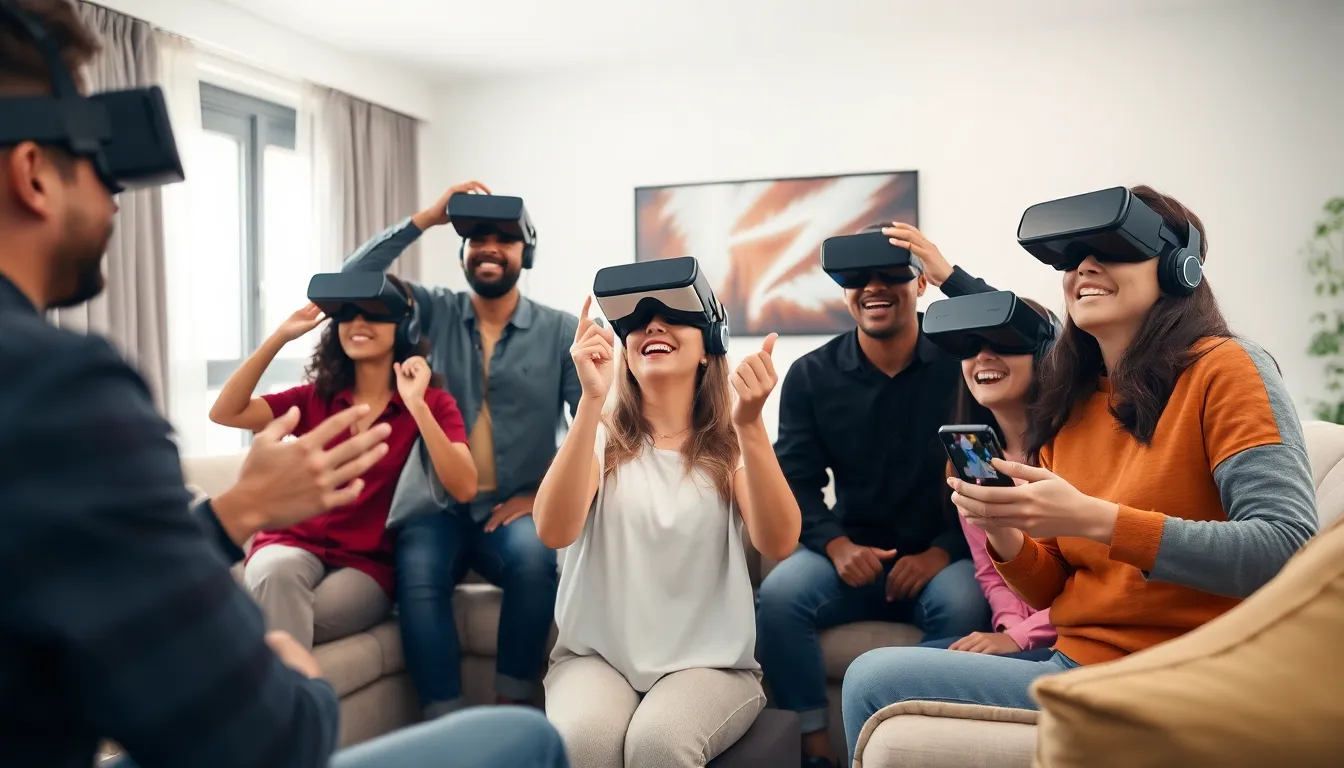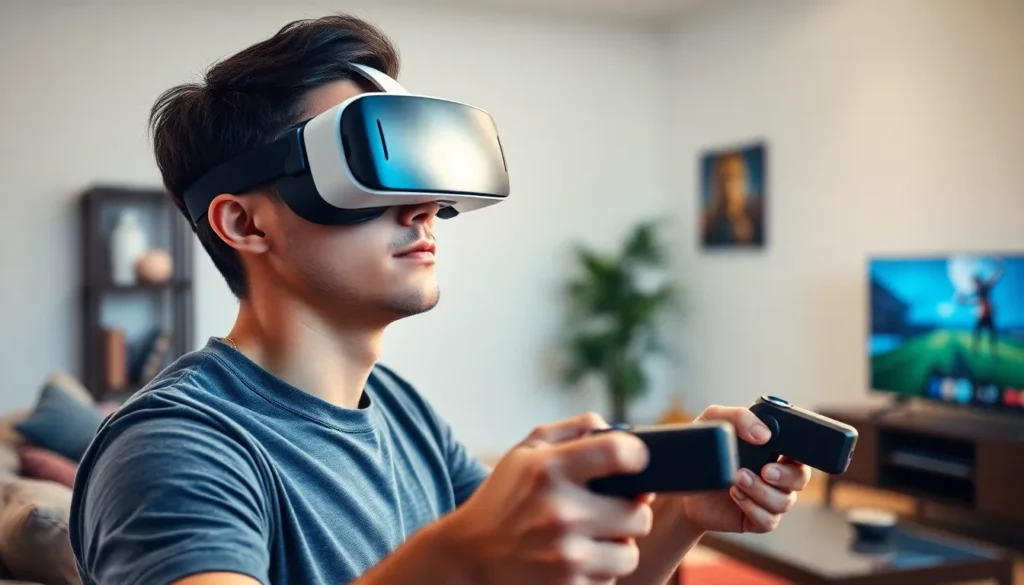Virtual reality has transformed the way people experience digital content, offering immersive adventures that were once the stuff of science fiction. As this technology continues to evolve, choosing the right VR headset can feel overwhelming. With a plethora of options available, each boasting unique features and capabilities, it’s crucial to find the perfect fit for individual needs.
In this article, readers will dive into comprehensive reviews of the latest VR headsets on the market. From casual gamers to serious enthusiasts, there’s something for everyone. By examining performance, comfort, and value for money, this guide aims to simplify the decision-making process, ensuring users can fully enjoy the captivating world of virtual reality.
Table of Contents
ToggleOverview of VR Headset Reviews
VR headset reviews provide crucial insights into the performance, specifications, and user experiences associated with various models. Each review examines key factors such as display quality, field of view, tracking precision, and compatibility with different platforms, ensuring users find headsets that meet their specific needs.
Reviews often include comparisons of popular models, highlighting strengths and weaknesses. The analysis focuses on aspects like comfort during extended use, ease of setup, and the availability of exclusive content or features.
Assessments include feedback from both casual gamers and serious enthusiasts, reflecting a range of preferences and expectations. Performance metrics, such as refresh rates and resolution, play a significant role in these evaluations.
Value for money is a central theme in reviews. Each headset’s price point is aligned with its features and overall performance, guiding consumers in making choices that fit their budgets. Extensive research backs the reviews, drawing on expert evaluations and user testimonials for credibility.
Ultimately, VR headset reviews aim to equip potential buyers with the knowledge needed to navigate the diverse landscape of available products, ensuring a satisfying and immersive virtual reality experience.
Popular VR Headsets in 2023

A range of VR headsets caters to various user preferences and budgets in 2023. This section explores high-end models, mid-range options, and budget-friendly choices available in the market.
High-End Models
High-end VR headsets offer superior performance and unmatched immersive experiences. Key models in this category include:
- Valve Index: Known for its high refresh rate of 144 Hz, the Valve Index provides stunning clarity and a wide field of view at 130 degrees. It features precise tracking through external base stations and includes finger-tracking controllers.
- Meta Quest Pro: This model boasts advanced mixed reality capabilities and a sleek design focused on professional applications. With 1800 x 1920 resolution per eye, it delivers excellent visuals and supports a wide range of productivity apps.
- HTC Vive Pro 2: The Vive Pro 2 supports 2448 x 2448 resolution per eye and a 120-degree field of view. Enhanced audio and ergonomic design ensure comfort during extended sessions, making it ideal for serious gamers and developers.
Mid-Range Options
Mid-range VR headsets balance performance and affordability. Notable examples include:
- Meta Quest 2: This standalone headset features a 1832 x 1920 resolution per eye and supports both VR gaming and social applications without the need for external hardware. Its accessibility and comprehensive library of games make it a popular choice.
- Pimax Artisan: Offering a unique 140-degree field of view, the Pimax Artisan delivers 2560 x 1440 resolution per eye. With modular accessories available, users can customize their experience for different applications.
- Sony PlayStation VR: Designed for PlayStation 4 and 5, this headset offers a 1920 x 1080 resolution and compatibility with a large library of games. Its integration with the PlayStation ecosystem enhances the gaming experience.
Budget-Friendly Choices
Budget-friendly VR headsets cater to entry-level users, providing an affordable way to explore virtual reality. Key options include:
- Oculus Go: This standalone headset features a simple setup with a 2560 x 1440 resolution and supports various applications for casual users. Its portability and ease of use make it a good entry point for newcomers.
- Samsung Gear VR: Utilizing smartphones for display, the Gear VR offers a budget option for users with compatible devices. It provides a resolution dependent on the connected phone and includes basic VR experiences.
- Lenovo Mirage Solo: This headset features a 2560 x 1440 resolution, built-in tracking, and standalone functionality. It allows users to enjoy immersive experiences at an affordable price, making it suitable for casual gaming and exploration.
Features to Consider in VR Headset Reviews
When evaluating VR headsets, certain features significantly impact the user experience. Key aspects include display quality, comfort and fit, and tracking technology.
Display Quality
Display quality directly affects immersion in virtual reality. Factors to consider include resolution and refresh rates. A higher resolution, such as 2160 x 2160 pixels per eye, provides clearer visuals, reducing the screen-door effect. Refresh rates above 90 Hz enhance fluidity, making movements and interactions seamless. Users should assess the color accuracy and brightness levels for optimal performance, especially in varied lighting conditions.
Comfort and Fit
Comfort and fit play essential roles during extended VR sessions. Adjustable straps, lightweight materials, and ergonomic designs contribute to a headset’s comfort. Look for headsets with padding around the face and adjustable optics to accommodate different facial shapes. A well-fitting headset minimizes fatigue and distractions, allowing users to immerse themselves fully in VR experiences.
Tracking Technology
Tracking technology determines the accuracy of movements in virtual environments. Different headsets utilize inside-out tracking, external base stations, or a combination of both. Inside-out tracking, utilizing cameras on the headset, offers greater flexibility and ease of setup. Conversely, external tracking systems, such as those found in the Valve Index, provide higher precision. Assessing the tracking range and latency is critical, as it affects overall responsiveness during gameplay and applications.
User Experience Insights
User experience shapes the effectiveness of VR headsets across various use cases. Understanding insights into gaming performance, media consumption, and social interaction enhances the overall value of these devices.
Gaming Performance
Gaming performance directly influences immersion and enjoyment. High refresh rates—ideally exceeding 90 Hz—improve responsiveness and reduce motion blur. Models such as the Valve Index and HTC Vive Pro 2 excel with superior tracking precision, offering competitive advantages for serious gamers. The Meta Quest 2 provides solid performance at a more affordable price, balancing quality with accessibility. Users seeking diverse gaming options benefit from extensive libraries of compatible titles and exclusive content tailored for different platforms. Comfort during long gaming sessions also plays a significant role, with adjustable head straps and lightweight designs minimizing fatigue.
Media Consumption
Media consumption in virtual reality offers a unique experience compared to traditional viewing methods. Many headsets, like the Meta Quest Pro, support high-resolution content, with some reaching 4K displays per eye. Viewers enjoy immersive environments, making films and shows more engaging. Several platforms deliver a range of content, from 360-degree videos to VR cinema experiences. The spacious field of view enhances the sensation of presence, adding depth to storytelling. Additionally, built-in features such as spatial audio create a surround sound experience, further elevating the enjoyment of cinematic content.
Social Interaction
Social interaction in VR fosters new connections and shared experiences. Many headsets incorporate social platforms for multiplayer gaming and virtual meet-ups. Users can engage in virtual spaces through avatars, enabling more immersive interactions than conventional video calls or chat platforms. Examples include Facebook Horizon and Rec Room, which allow users to socialize in user-generated environments. Voice chat features facilitate real-time communication, enhancing the collaborative aspect of gaming and social engagements. Overall, VR social platforms redefine how individuals connect, offering unique opportunities for distance connection and shared experiences.
Future Trends in VR Headset Technology
Advancements in VR headset technology continue to reshape the virtual reality landscape. Innovation drives improved immersion, enhanced user experiences, and broader applications in various fields.
Adoption of Eye-Tracking Technology
Eye-tracking technology increases realism and interactivity. By detecting where users look, headsets can enhance graphical fidelity in specific areas, optimizing rendering processes. This development also facilitates foveated rendering, improving performance without increasing computational burden.
Integration of Augmented Reality (AR)
AR integration within VR headsets blurs the lines between digital and physical worlds. Mixed reality experiences allow users to engage with both virtual and real elements simultaneously. This trend expands applications in gaming, education, and professional training.
Improved Comfort and Ergonomics
Design improvements focus on user comfort for prolonged use. Manufacturers prioritize lightweight materials, adjustable components, and better weight distribution. Enhanced ergonomics reduce fatigue, making extended VR sessions more enjoyable.
Wireless Technology Advancements
Wireless VR headsets become increasingly popular, offering greater freedom of movement. Reduced latency solutions and improved battery life enhance the wireless experience. Users enjoy seamless connectivity without hindrances from cables.
Enhanced Social Features
Social interaction within VR continues to grow. Future headsets will likely include more robust community features, allowing users to meet and interact in virtual spaces. Enhanced social tools will redefine gaming experiences and facilitate collaboration.
Expansion of Content Libraries
Content libraries expand as developers create more diverse applications. Upcoming headsets will feature a variety of gaming titles, educational programs, and productivity tools. Broader content selections attract casual users and industry professionals alike.
Sustainability in Manufacturing
Sustainability trends impact VR headset production. Companies pursue eco-friendly materials and energy-efficient manufacturing processes. Consumers increasingly prefer products with a lower environmental footprint, influencing purchasing decisions.
Artificial Intelligence Integration
AI technology enhances user experiences by personalizing content and recommending relevant applications. AI algorithms analyze user behaviors, tailoring interfaces and experiences to individual preferences. This integration improves overall satisfaction and engagement.
These trends illustrate the dynamic nature of VR headset technology. As innovations continue to emerge, the future promises even more exciting advancements in virtual reality and its applications.
Navigating the world of VR headsets can be overwhelming with so many choices available. Each model offers unique features tailored to different user preferences and budgets. By focusing on performance comfort and value for money consumers can make informed decisions that enhance their virtual reality experiences.
As technology continues to evolve the future of VR headsets looks promising with advancements in tracking technology and increased immersion. Whether for gaming media consumption or social interaction the right headset can open up a new realm of possibilities. Staying informed about the latest reviews and trends will ensure users find the perfect fit for their needs.




